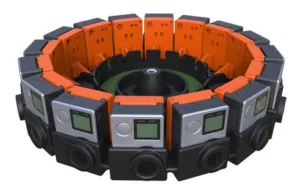One of the challenges faced by participants in the Virtual Reality industry is to make creating and watching VR simpler for consumers.

To that end, Google has launched a new open source VR platform called Jump. Jump can be described as an entire ecosystem for creating virtual reality videos. The system consists of three parts: a camera rig, software that automatically assembles and processes the video and a player/viewer.
The Jump rig consists of 16 GoPro HERO4 camera modules positioned in portrait orientation and arranged in a circular array. An optional central microphone can be included to record synchronized sound. The size of the array appears to have been chosen as a compromise between keeping the captured image at a high quality level and making the camera rig portable. The demo array is designed to be mounted on a tripod. The 16 cameras share frame-level synchronization as well as other settings to assure that the images are in a condition such that they can be successfully combined. In a sense, the 16 cameras are set-up to act as if they were one single camera.
At this time, there is no word on the price of the GoPro based Jump camera rig or the date it will be available. It should be noted, however, that while GoPro is the first company Google has partnered with on a Jump rig, content creators should be able to use any commercially available cameras.
To that end, Google has determined “The size of the rig, the number and placement of the cameras, their field of view, relative overlap – every last detail”. The company intends to publicly release plans of the Jump camera’s “geometry” sometime this summer. This means that anyone who wishes to do so can make a Jump camera array. The rig is optimized to work with the Jump Assembler.
The Assembler software can create stereoscopic VR video from the Jump rig’s 16 raw video feeds. The Assembler software integrates not only the 16 captured scenes but also generates in-between viewpoints.
The resulting assembled 3D video has a very high resolution, the image is equivalent to that produced by five 4k TVs. It is claimed that, in the final video product, the user is able to experience high quality imagery in every direction. Near things look near, far things look far. The user does not see borders between images spliced together from adjacent cameras. As the user shifts their head to the right or left, the perspective of the objects in the video all shift properly.
Instead of building a new kind of player specific to immersive, stereoscopic VR video, Google plans to make Jump an option available in the YouTube player, YouTube being owned by Google. This, in turn, will allow users the opportunity to experience stereoscopic VR video from their Android smartphone in conjunction with Google’s cardboard viewer or by the use of any suitable headset.
At this time, Jump is not generally available. It is planned that select creators will get access to Jump starting this summer. – Arthur Berman

